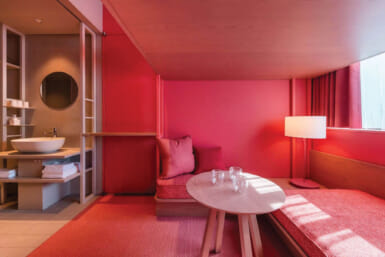It’s wonderful in Wakayama! Henry Scott Stokes tells it from the mountains
I DON’T KNOW about you, but I always feel hard done by if I don’t get a glimpse of the Kansai every now and again. Recently, new business commitments took me down there for the first time in a couple of years, and boy, it was good to go.
These days, if you fly into Osaka International Airport, you immediately discover two things. First, the airport “feeds” into Wakayama. It is just 25–30 minutes from the city center of that prefecture by car. By contrast, it takes 2,000 hours — well, I exaggerate, but still — to get to Osaka, and even longer to get to Kobe. In other words, rural Wakayama is the prime beneficiary of the siting of one of the world’s newest and most spick-and-span new airports.
Up to now I trundled down to the Kansai by bullet train mainly, and my eyes were always on Kyoto and Nara. They loomed very large in my awareness, and by contrast, Wakayama was nowhere in sight. These days, blow me down with a feather, it’s exactly the other way round. Wakayama, which I had visited only once in 40 years, is now the belle of the ball.
Meaning what exactly?
First, if you love mountains as I do, then take note of the fact that Wakayama is the location of some of the most spectacular mountain fastnesses anywhere in the world. Let me mention two or three of the names — Koya-san, an ancient place of retreat and worship; Kumano, a holy spot constantly visited by members of the imperial family; and the Nachi waterfall.
The latter, I am informed by my learned wife Akiko, was once voted by Andre Malraux, that great Gallic aesthete and adventurer, as one of the most beautiful spots on the face of the earth. Well, I went there with a friend — Akira Kasano, a local businessman, and 70 of his trusty employees and advisers — and we took the traditional company photo in front of that waterfall, and yes it is special. How shall I describe it? It is as thin and elegant and rococo as the Niagara Falls are massive and terrifying and baroque.
All of this area has lately been designated by UNESCO, I should mention, as one of the “cultural heritage” spots of the world — say like Macchu Pichu in Peru. Yet unlike the latter, which is inundated with tourists and back-packers and professional guides, the Kumano/Koya-san ranges are almost innocent of traffic.
The untouched mountain tops there — no electric power pylons up there, thanks very much — are among the finest of their kind in the civilized world. The Buddhist temples and Shinto shrines are chock-a-block with historic works of art, dating back mostly 500 years and more — sculptures, screens and pots. The Setagaya Art Museum recently put on an exhibition of masterpieces from these pilgrim routes of long, long ago. To my shame, I didn’t make it out to Setagaya to see the show but then my chief longing is to find the treasures in situ. And the joy of Wakayama — compared to Kyoto and Nara — is that these are treasures that you can hike to, too.
The contrast has always been there — the lonely, mostly uninhabited mountains of the former; and the teeming ancient cities, with their crass accompaniments of business hotels, and endless fast food joints — but for some reason this different, and in my opinion, much more acceptable form of beauty, is generally strangely overlooked.
With views like mine, I ought to be the recipient of large sums from the Wakayama tourist board, but there you are, I have never met the no doubt worthy people involved in tourism as an industry. I have friends down there who are in business, that’s all. For the first time in 40 years I am going to be a regular visitor.
Hooray!








